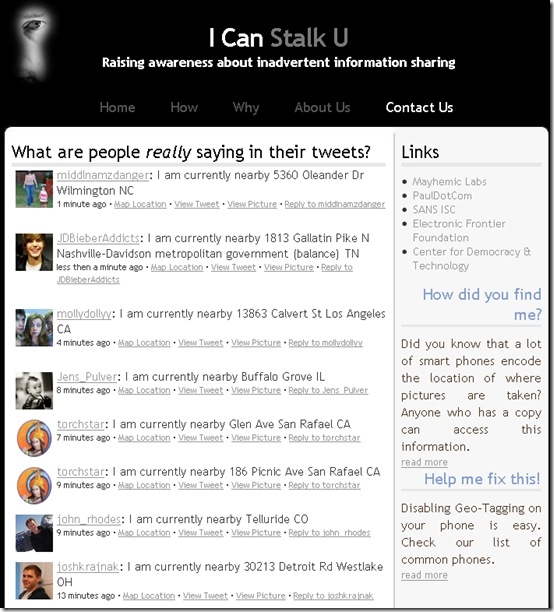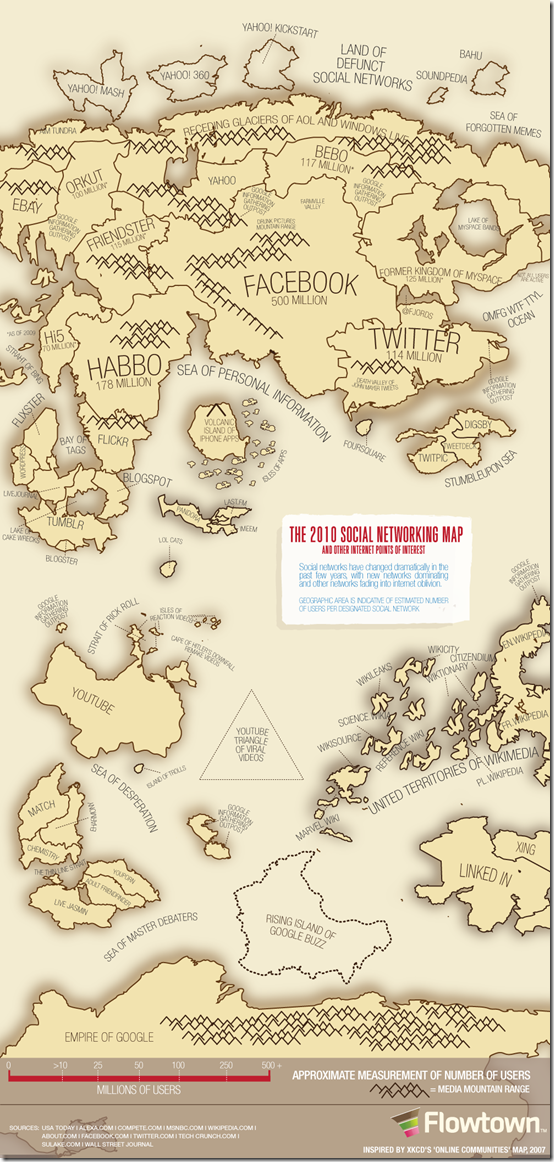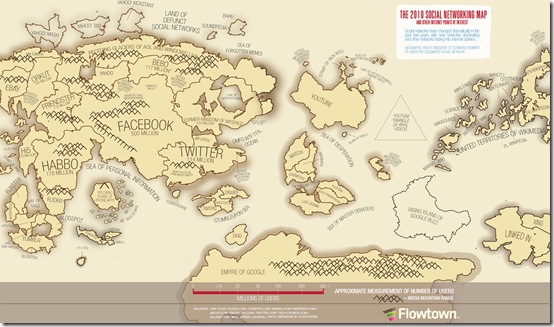Home » 2010 (Page 7)
Yearly Archives: 2010
Digital Culture Links: August 16th 2010
Links for August 12th 2010 through August 16th 2010:
- Cultural Studies – Crafting Fictional Personas With the Language of Facebook [NYTimes.com] – Interesting if very judgmental piece which is ostensibly looking at a fictional Facebook profile as part of a fiction narrative, then suggests that all Facebook profiles are fiction: “…a brilliant stroke to use Facebook for novel writing, because in general Facebook feeds on fiction; it consumes it, and spits it out in every direction. Being “friends” on Facebook is more of a fantasy or imitation or shadow of friendship than the traditional real thing. Friendship on Facebook bears about the same relation to friendship in life, as being run over by a car in a cartoon resembles being run over by a car in life. Facebook is friendship minus the one on one conversation, minus the moment alone at a party in a corner with someone (note to ninth graders: chat and messages don’t count); Facebook is the chatter of a big party, the performance of public cleverness, the facades and fronts and personas carefully crafted, the one honed line, the esprit de l’escalier; in short, the edited version.”
- When to use i.e. in a sentence [The Oatmeal] – Want to know when to use ‘i.e.’ or ‘e.g.’ properly – the Oatmeal has funny words with pictures to clarify these confusing issues. 🙂
- NBN crucial to health of economy: expert [WA Today] – My colleague Matthew Allen talks about the importance of the NBN for future development in Australia: “Australia’s economy would suffer if work to improve internet speed and availability isn’t immediately started, according to a Curtin University internet expert. Internet studies Professor Matthew Allen said Labor’s national broadband network may take longer to roll-out and cost more than the Coalition’s plan but it would be of greater benefit in the long run. The government yesterday announced its $43 billion national broadband network would be upgraded to provide speeds of up to one gigabyte per second, making it 10 times faster than was originally touted.”
- Pushing Our (Tweet) Button [Twitter Blog] – Twitter releases its official ‘tweet this’ button, which can be included on any website with just a few lines or code. It’s fairly similar in style to Facebook’s ‘Like’ button, but obviously performs a slightly different function. I quite like the option to include a counter showing how many times a post has been retweeted already – the counter seems to include retweets using most popular url shortening services!
- Whiteboard girl hoax fools thousands on net [BBC News] – Shocking almost no one, it turns out that the hugely popular net sensation ‘Jenny’, who quit her job using a series of messages on whiteboards, is a hoax, orchestrated by thechive.com. The model’s name is Elyse Porterfield and today she and thechive.com admitted the hoax.
I Can Stalk U
I Can Stalk U is another one of those very simple websites which highlights how information already being shared by people everyday may be used in ways we’ve not necessarily thought through. In a similar vein to Please Rob Me, which highlighted tweets where people indicated they were leaving their home, I Can Stalk U illustrates how much information many people are inadvertently sharing via the geographic photo tagging in many smartphones (including iPhones). On the I Can Stalk U website, each tweet that includes geotagged photos is translated (ie the metadata is read, and presented), showing the approximate address, this address on a Google Map, the picture it was attached to, and a link to the original tweet. All of this information is publicly accessible, the website is simply putting the geotag information up front, rather than the original tweet. Here’s an screenshot from the website:
Often these sort of websites can be a bit confronting for people who’ve not thought about their privacy in relation to geotagged photos. The whole concept of metadata – literally, ‘data about data’ – which can so easily be embedded in photos, is a bit disconcerting for many people who may not have realised it was there. Thankfully, despite the initially confronting website, I Can Stalk U is set up as an educational tool, showing what data is unknowingly being shared, and telling you how to fix that if you don’t want this information out there on the web. On their ‘How’ page, the I Can Stalk U folks provide details on how to disable geotagging for iPhones, Blackberries and some other popular smartphones. If you’ve got one and it’s not on the list, it’s worth disabling the geotagging unless you’re 100% comfortable with every photo you take (and share) embedding the where, when and on what that photo was taken.
Creative Commons Roadshow: Perth, September 2 2010

Want to learn more about the Creative Commons? Want to hear about the latest development nationally and beyond? Want to hear from Perth folks who’ve been using the Creative Commons as part of education, the creative industries and even government? Then the Creative Commons Roadshow is for you and, for the first time in ages, the show’s coming to Perth.
Date: 2 September 2010.
Times: 10.00 am – 3.30 pm.
Venue: State Library of Western Australia, Alexander Library Building, Perth Cultural Centre, Perth
You can check out the program here; the exact speakers are still being finalised and will be added once the details are sorted, but I’ll definitely be talking about the Creative Commons in Education during the local champions segment from 1-2. If you’re interested, please come along: it’s a free event, all you need to do is register here (and please try and indicate your areas of interest, to the CC Team know which topics to focus on during the afternoon discussion groups).
I really enjoyed being part of the Building an Australasian Commons event that the Creative Commons Australia ran in Brisbane in 2008, but it’s even better to the CC team touring the country and I hope lots of Perth folks will come and hear how Creative Commons licensing and ideas can enrich your learning, sharing, creating and more!
Update: Here’s the program for the day …
CC Roadshow – Perth – Program
On the folly and farce of the Coalition’s broadband policy in Australia
 As part of their election campaigning, the Coalition yesterday released their $6billion broadband plan for the next eight years. To say the very least, it’s a bad policy, filled with either technical errors or misrepresentations, and does nothing to situate Australia as a major player in a digital economy. Earlier today I spoke with Travis Collins on RTR FM’s Morning Magazine about the Coalition policy.
As part of their election campaigning, the Coalition yesterday released their $6billion broadband plan for the next eight years. To say the very least, it’s a bad policy, filled with either technical errors or misrepresentations, and does nothing to situate Australia as a major player in a digital economy. Earlier today I spoke with Travis Collins on RTR FM’s Morning Magazine about the Coalition policy.
It’s fair to say that the coalition’s approach to broadband is one of contempt and ignorance; you only need to watch our potential Prime Minister, Tony Abbott struggle to give any meaningful answers about the policy on last night’s 7.30 Report to see this is an area in which no significant thought or time has been invested. The ad hoc patchwork policy proposed simply milks a tiny bit more out of existing cables and infrastructure, with no long-term planning, no long-term development and a completely unrealistic assumption that private industry will want to invest in national fibre-optic infrastructure. As Mark Pesce clearly argues, there are speeds that can only be achieved, maintained (and, if needs be, expanded) using fibre; wireless and existing copper cables just can’t stretch much further, but the massive investment needed here is surely a national government priority. We don’t expect private enterprise to fund the national roads; the government invests in these because it allows traffic to move across the country. I would argue that the best way to understand our broadband needs are the same: get a high-speed network in place, and the investment, innovation and development will come. Without it, innovation will stall and Australia’s position in the digital economy will be one of weakness and embarrassment.
Industry responses to the Coalition’s plan have been unanimously negative, with the only kind comments being for the one element that replicates a section already in Labor’s National Broadband Network plan. Indeed, David Braue’s recap on ZDNet of the Coalition’s last 24 hours of broadband discussion makes it crystal clear that they have no idea what they’re talking about when it comes to broadband, the internet, or most other things to do with telecommunications in Australia. What is clear is that the Coalition’s plan would ensure Australia has one of the slowest internet capacities of any Western (and many other) countries today and for many years to come. Sure, their plan is cheaper, but not buying things that you actually need is never a good policy.
Now, don’t get me wrong, I still think the time and energy Senator Conroy has wasted on an ineffective and unwelcome national internet filter is incredibly disappointing, but Conroy has already back-pedalled substantially, deferring the filter until a review of the Refused Classification ratings system in Australia. (And, implicitly, setting up this, or the likely senate balance of power going to the Green’s, as a way of saying he did his best on this promise, but was blocked by others.) In the meantime, the NBN is the best thing Conroy has worked on, and the current Labor NBN plan is a million times better for Australia, ensuring speeds that allow Australians to participate in the best, brightest and fastest developments online, rather than living in the slow, crawling digital backwater which could see Australia at the mercy of a new new tyranny of distance, lagging behind in the international digital economy.
Digital Culture Links: August 10th 2010
Links for August 4th 2010 through August 10th 2010:
- Women Set the Pace as Online Gamers [NYTimes.com] – “Although women are still slightly in the minority among global Web users, they are closing ground with men and, once connected, spend about two more hours online a month on average. […] Women also outpace men in photo sharing and shopping, and in what may come as a surprise, gaming, favoring casual puzzle, card and board games. Female gamers over 55 spend the most time online gaming of any demographic by far and are nearly as common as the most represented group, males 15 to 24.”
- Wikipedia’s Lamest Edit Wars [Information is Beautiful] – Fantastic infographic showing a timeline of some of Wikipedia’s silliest editing wars.
- Omo GPS stunt opens doors for marketers [News.com.au] – Unilever Brazil has embedded 60 GPS trackers in OMO washing liquid bottles and then their teams have followed the pruchasers of these bottles home and given them prizes. Understandably, many privacy issues have been raised!
- Does Facebook unite us or divide us? [CNN.com] – Brilliant, and a little confronting, TED talk from Ethan Zuckerman (senior researcher at Harvard University’s Berkman Center for Internet and Society) looking at how globalisation might be a technical achievement, but not a social or mediated one (“cosmopolitan globalisation”). We look to our own social networks, and they increasingly narrow our perspective rather than broadening it.
- Update on Google Wave [Official Google Blog] – Google Wove: Wave development ceases, after users find it’s all too complicated.
- CommBank app lets people snoop on your house [SMH] – House-pricing information is apparently available to the public generally, but there is a real sense of privacy invasion at work here: “There’s a brand new property app on the block that gives iPhone users detailed information on the value of any house they care to point their handset towards, but privacy experts warn it may not sit well with the neighbourhood watch. Detailing sales prices of 95 per cent of Australian homes, the free app has been launched by the Commonwealth Bank in a bid to deliver more immediate buying and selling information to the public as they are actually viewing properties, helping them to ward off rogue sellers who attempt to talk up property prices. Just by pointing an iPhone at a particular property, they will be able to see the last sale price of the property, and if the home is actually for sale, the app will bring up a listing from realestate.com.au with details such as home layout and pictures.”
- Thunderous Bolt sensitive to parody [ABC The Drum Unleashed] – Jason Wilson weighs in on fake Twitter profiles in the wake of Andrew Bolt’s angry denouncement of (fake) himself: “Online fakery is something that draws on different strands in online and offline cultural history. Apart from drawing on early online examples like Fake Steve Jobs, Twitter faking has links with political impersonation, writing techniques like pastiche, and it also has some relationship to genres like fan fiction. After all, the best fakes don’t just go after their targets with blunt instruments, they create a narrative world for the fake persona to inhabit …”
2010 Social Networking Map
A great 2010 update from Flowtown’s Ethan Bloch of the (in)famous XKCD Map of Online Communities.
Update: Or you might prefer your map horizontally …



